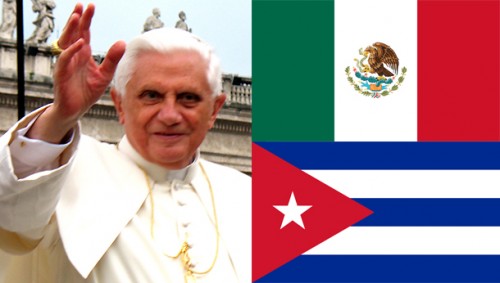 In the lead-up to Pope Benedict XVI's trip to Mexico, news reports were oddly obsessed with a sort of popularity contest between the current and preceding pope. We kept joking about the secret "enthusiasm meters" reporters must be consulting to come up with stories such as this one from December:
In the lead-up to Pope Benedict XVI's trip to Mexico, news reports were oddly obsessed with a sort of popularity contest between the current and preceding pope. We kept joking about the secret "enthusiasm meters" reporters must be consulting to come up with stories such as this one from December:
Mexican worshippers underwhelmed by papal visit
Or this one from last week:
Predominantly Catholic Mexico not exactly thrilled about the pope’s visit this week.
You always knew where this popularity contest would end up, didn't you. Here's the Boston Globe's headline for a recent piece on the pope's visit:
Pope's arrival in Mexico sparks surprising emotion.
So maybe that secret enthusiasm meter the reporters have access to could use a tune-up. There's also this Associated Press piece headlined:
Mexico joyfully welcomes Pope's visit
Of course, some of us are wondering whether there might be more substantive news about the visit than how popular or unpopular Benedict is.
I thought this New York Times piece did a pretty good job of telling a bigger story. Here's a part:
For his audience in Mexico, where Catholics are distraught over the deaths of 50,000 people since the government’s war against drug cartels began in late 2006, Pope Benedict emphasized that Mexico’s violence was caused by greed. The church, he told reporters on the papal plane, has a “great responsibility” in a country that is 83 percent Catholic to guide young people away from that false promise, “to educate the conscience, teach moral responsibility and strip off the mask, the idolatry of money that enslaves mankind.”
Speaking about Cuba, the pope also said on the plane that “Marxist ideology as it was conceived no longer corresponds to reality,” and he urged Cubans to “find new models, with patience, and in a constructive way.”
He added that the Catholic Church could play a key role in the transition to a post-Castro era. “In this process, which calls for patience but also much decisiveness, we want to help, in a spirit of dialogue, to avoid traumas and to help move toward a society that is fraternal and just, which is what we desire for the whole world,” he told reporters.
It remains to be seen how far Benedict will go in criticizing the Cuban government for its limits on human rights, and the Mexican government for its violent drug war, but within minutes of his arrival here, it was clear that he is likely to receive a warm welcome from the clergy and faithful.
I would have liked a bit more on the substance of the visit but the rest of the article was focused on contextualizing the visit -- we get the obligatory references to Benedict's comparative unpopularity and then a good six paragraphs on the scandal surrounding Father Marcial Maciel Degollado who, among other things fathered children out of wedlock, and Legionaries of Christ.
The Times has a good Cuba report, too. Completely different reporters are covering the two countries' visits and they seem to have a nice balance of knowledge about the Vatican and the host country. The Times report from Cuba focused on the delicate position of the church after decades of forced atheism.
This Associated Press account was interesting, suggesting that any membership hardships the church faced in recent decades was due to left-leaning Catholics upset that the church didn't embrace liberation theology. There's no mention of the gains made by evangelical Protestants or any other religious group.
Both that AP story and this Reuters story had brief mentions of anti-clericalism in Mexico. Here's Reuters:
On his way to the venue, the pope flew by helicopter over the giant hilltop monument with the statue of Christ the King, a symbol of the often stormy religious heritage of Mexico, which was officially anti-clerical for years after a 1910 revolution.
These references could have been fleshed out more and were in the New York Times piece mentioned above. Reuters also had this curious line:
The 84-year-old pope, wearing purple and white vestments, sprinkled the sermon he read from a massive white altar platform on a hillside with words such as conversion and reconciliation.
I know why he was wearing purple, as does any other liturgical Christian, but should it be explained to readers who don't know? Also, that "sprinkling" language is weird, no? You don't sprinkle sermons with words, usually. Or Benedict doesn't seem to, at least. His sermons are usually pretty well composed and thought out. The language doesn't match his style, in my opinion.
The final piece in the round-up is this Associated Press about the ebullient crowds that met Benedict. The reader who sent it in writes:
I read this thinking, "Hey, nothing about BXVI's trying to prop up a pro-Catholic president. Hey, they're willing to not stifle Benedict with passive-aggressive John Paul II comparisons."
Then I found this: "...respect and adoration for the papacy itself, the personification for many of the Catholic Church, and God." Personification of the Church? Look up "Body of Christ" in the Catechism--it's all online in several languages.
Personification of God?!?!?! Look up "Incarnation" in the Catechism. And please put down the Jack Chick tract.
Yes, probably wise to be a bit more careful with our language when writing about, well, the Body of Christ, the pope, the church, etc.
